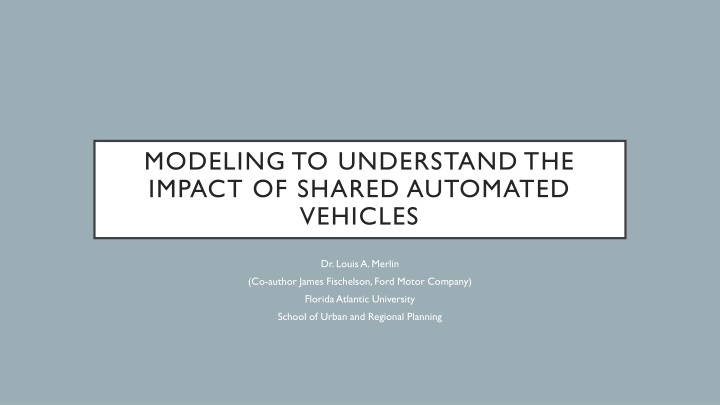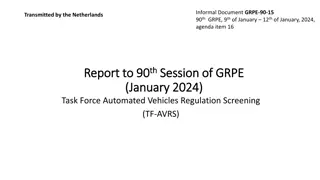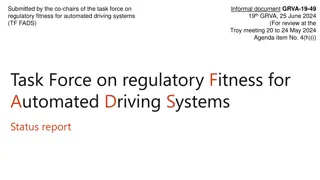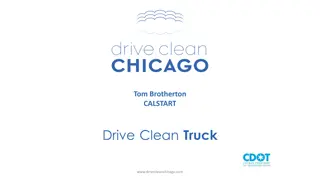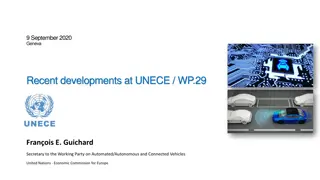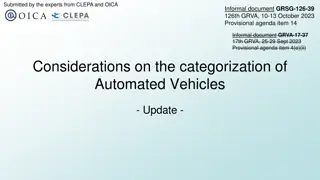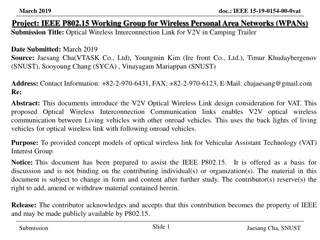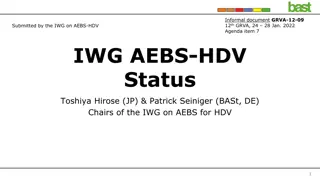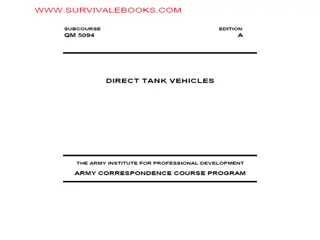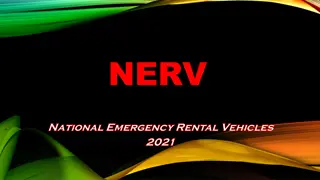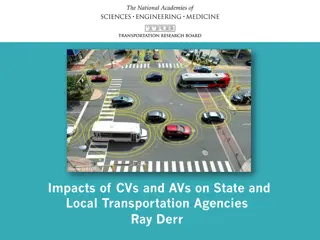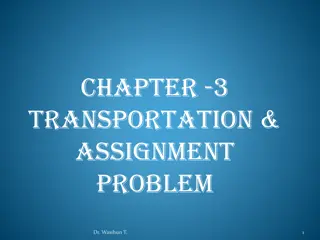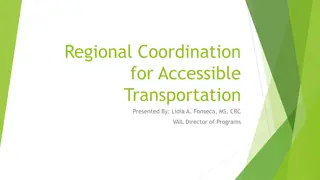Impact of Shared Automated Vehicles on Transportation System Performance
This study by Dr. Louis A. Merlin and James Fischelson explores the potential impact of shared automated vehicles on transportation systems. By reviewing 39 papers and simulations, the research delves into the implications of new shared automated modes, such as automated taxis, shuttles, and shared rides. The analysis aims to understand the effects on performance, costs, and convenience within the transportation network.
Download Presentation

Please find below an Image/Link to download the presentation.
The content on the website is provided AS IS for your information and personal use only. It may not be sold, licensed, or shared on other websites without obtaining consent from the author.If you encounter any issues during the download, it is possible that the publisher has removed the file from their server.
You are allowed to download the files provided on this website for personal or commercial use, subject to the condition that they are used lawfully. All files are the property of their respective owners.
The content on the website is provided AS IS for your information and personal use only. It may not be sold, licensed, or shared on other websites without obtaining consent from the author.
E N D
Presentation Transcript
MODELING TO UNDERSTAND THE IMPACT OF SHARED AUTOMATED VEHICLES Dr. Louis A. Merlin (Co-author James Fischelson, Ford Motor Company) Florida Atlantic University School of Urban and Regional Planning
AUTOMATION BRINGS THE POTENTIAL OF NEW MODES Public Transit Uber/Lyft Private Vehicle Shared Automated Vehicles Automated Variable Variable Shared Shared or Private Driver Routing Scheduling Shared Vehicle Shared Ride Human Fixed Fixed Shared Shared Human Variable Variable Shared Private Human Variable Variable Private Private
SHARED AUTOMATED VEHICLE MODES Automated taxi/automated Uber Variable route, variable schedule, private ride On demand transportation Automated shared ride taxis Variable route, variable schedule, shared ride Automated shuttles Semi-flexible route, semi-flexible schedule, shared ride I.e. Kustuplus or Via Larger vehicle for more ride sharing capability Lower cost
AUTOMATION AND SHARED MOBILITY Various forms of shared mobility have always been around Jitney, taxi, slugging, carpooling Automation makes shared mobility more affordable and more convenient Ability to travel point-to-point on demand Automated shared mobility expected to cost much less per mile than human- driven taxis, perhaps lower than privately owned vehicles Advantage of avoiding the need to park
PROBLEM STATEMENT How will new shared automated modes impact the performance of the transportation system? Difficult to tell because there is no real-world data on how such systems perform Models and simulations have been used to determine the what if impacts of such systems Here we review such models and simulations and try to generalize across methods and results
PAPERS REVIEWED Reviewed 39 papers simulating SAV systems Papers published between 2011-2016 Discovered primarily through personal knowledge of the literature, attending the Automated Vehicle Symposium Google scholar alerts on early papers, i.e. Transforming Personal Mobility Many papers not peer reviewed white papers, government research reports, etc.
Agent-based models Network assignment models MODELING APPROACHES Aggregate models
AGENT-BASED MODELS (ABM) Describe the behavior of individual actors, so capable of great descriptive detail, including variation over time and space Agents model the behavior of vehicles and travelers Time is modeled via steps Well suited to modeling detailed interactions between vehicles and users pick up, drop off, ride sharing, etc. Not possible to find optimal system through ABM Behavior often simplified through rule-based systems
NETWORK ASSIGNMENT MODELS Assign vehicles across a network to meet all passenger demand Algorithmic approach to reach solution Less flexible about measuring behavior and interactions Strong at optimization
AGGREGATE MODELS Use simplified equations describing aggregate behaviors Useful for estimating system-level performance Expedite comparisons across cities and contexts Highly dependent upon initial assumptions, may not uncover emergent behaviors
MODELING CHOICES AND ASSUMPTIONS Many assumptions are made when modeling shared automated vehicles The more detailed the model, the more assumptions and data it requires Therefore, many simulations are based on current day travel patterns and data Results of models can be highly dependent upon such assumptions Assumptions often have little empirical justification
MODELING CHOICES AND ASSUMPTIONS Context The geographic environment in which the SAV system will operate Market The set of travelers served by the system, including the spatial and temporal pattern of demand Service The set of vehicles and how they respond to demand Performance Metrics used for describing the performance of the system
CONTEXT Most models have only been built for a single geographic context, limiting the generalizability of their results; exceptions are Burns 2011 and International Transport Forum All models assume current-day infrastructure Almost all assume a fixed geography of service Speeds typically taken to be exogenous from an outside travel demand model Speed is endogenous in Levin and Boyle, Puget Sound Many models assume a fixed speed based on time of day and/or location Cost of vehicle automation assumed to be most typically between $5,000-$10,000 per vehicle
MARKET Most assume a fixed market size, such as a certain percentage of the current travel market For example, UT Austin and Georgia Tech assume a 2% market share Some systems assume 100% market share, which is not realistic in the short term Only a few systematically vary market share as an independent variable (Bosch Ciarri, Fagnant) Very wide range of trip densities from < 1 to over 10,000 trips per square kilometer per day Mode choice a key consideration Could be mode shift or could also be induced trips due to new service
SERVICE Automated taxis, automated shared ride taxis, or automated shuttles Models typically determine fleet size empirically via trial and error through simulations Most models assume real-time dynamic booking Vehicle assignment typically nearest empty vehicle/ greedy algorithm Most models assume total point-to-point service without stations Papers typical assume parking in place when not in use Some papers consider active rebalancing strategies Few papers compare multiple service options in the same modeling framework Few consider connections with transit, though some models assume that SAVs will feed into major transit lines (Zellner, Van Henteryck) Little consideration of boarding or alighting times
SUMMARY ABOUT MODELING ASSUMPTIONS Difficult to compare across modeling efforts due to very different assumptions about market share and mode choice Nearly all modeling efforts assume present day traffic and infrastructure conditions Few modeling efforts compare the same model across multiple geographic contexts or metro areas Almost no modeling efforts consider the impact of policies on SAV operations Non-standardized reporting makes it difficult to compare results across models
MODEL REPORTING STANDARDS Service Context Market Performance Passenger Wait Time Distribution Costs per Passenger Km Vehicle Utilization (hours per 24 hour day) City Population and Density Street Network and Speeds Baseline Market Size (Trips Per Day) Alternate Market Sizes Trip Densities (Trips per KM^2 per Day) Service Type Vehicle Allocation and Ride Sharing Behavior when Not Serving Customer Marginal Cost of Vehicle Automation Connections with Transit Special Limits or Considerations Trip Length Distribution Trips per Vehicle VKMT/PKMT Ratio Fleet Size and Determination Mode Choice Vehicle Replacement Ratio Economies of Scale Energy/CO2 Impacts Model Type
GENERALIZABILITY OF PERFORMANCE METRICS Recommended Reporting Results for Comparability Vehicle miles and hours; occupied / relocating / waiting Passenger miles and hours; waiting and in transit Useful passenger miles (VKT/PKT ratio) Trip density (trips / km^2 / hour) Trips per vehicle per day Miles per vehicle per day Cost per passenger kilometer Non-Generalizable Results Vehicle replacement ratio Environmental performance (Decrease in CO2 emissions)
WHAT HAVE WE LEARNED ABOUT SHARED AUTOMATED VEHICLES?
PERFORMANCE Most analyses find wait times under 5 minutes Most models estimated system costs at 0.25-0.30 cents/ passenger-km May underestimate complexity of automated vehicle maintenance and security Vehicle utilization around 7-8 hours per day of vehicle use and 10-40 trips/vehicle/day Relocation increases VKT by about 5-20%, but can run as high as 44% VKT reductions are possible with major boost in ridesharing; decrease of 50%+ possible Vehicle replacement ratio of 1:10 typical Lower number of vehicles does not necessarily mean less congestion, but it does mean less demand for parking Depends highly on context
SYSTEM DYNAMICS Wait times a non-linear function of fleet size If vehicle supply is sufficient to avoid queuing during the peak hour, then additional vehicles do little to reduce wait time Trade off between higher vehicle utilization and lower wait times
SYSTEM DYNAMICS Highly peaked demands make high vehicle utilization more challenging Ride sharing allows for higher vehicle utilization by smoothing out the peak Most ride sharing systems report moderate levels of sharing, averaging 1.5 passengers per vehicle or lower However ride sharing makes a smaller fleet work during the peak Systems becomes more efficient as their market size grows Higher trips per vehicle per day, shorter wait times, lower average costs per passenger km Fagnant finds slight economies of scale, 5% reduction in fleet size per trip when market demand doubles
CONSIDERATIONS FOR FUTURE MODELING EFFORTS Allow context, market, and service to be independent variables of inquiry Compare different SAV service types in the same geography Consider the same type of service operating in different geographies Consider changing the geographic scope of the service Model the impact of differential market shares What type of SAV service is most suited to each particular context and market?
CONSIDERATIONS FOR FUTURE MODELING EFFORTS Consider effect of a range of public policies on SAV system performance VKT fee policies Congestion pricing policies Consider interactions with public transit Consider public transit as an integral part of the overall system Allow for a range of passenger behaviors agents with different behaviors Model mode choice endogenously
RESEARCH QUESTIONS What if every Ann Arbor Transit Authority (AATA) passenger were served by an SAV system instead? What would happen to the level of service? What would happen to costs? What would happen to congestion? What would happen to carbon emissions?
SERVICE PERFORMANCE Ann Arbor Bus SAV, Single Rider SAV, Shared Rides SAV, Shared Rides Fleet Size 65 750 750 400 Mean Wait Time 6.2 - 9.5 4.1 3.8 4.8 95th Percentile Wait Time Unknown 14.0 9.0 11.5 Mean Travel Time 29.3 11.5 15.6 15.6 Sample Size na 3 1 3 * Bus travel time is for total trip ** Approximately 129,000 vehicles used for commuting in Washtenaw County
ENERGY PERFORMANCE Ann Arbor Bus SAV, Single Rider SAV, Shared Rides SAV, Shared Rides Carbon Emissions per Day (Tons) % Diff. from Bus System % Diff. from Single Ride System EPA MPG Carbon Emissions per Day (Low MPG) % Difference from Bus System Consumer Reports MPG 41,034 49,972 21.8% 23,544 -42.6% -52.9% 27,197 -33.7% -45.6% na 4.5 53 53 53 41,034 71,841 75.1% 33,725 -17.8% 38,365 -6.5% na 4.5 37 37 37
DISCUSSION: BENEFITS OF RIDE SHARING FOR SAV SYSTEM A shared ride SAV system serving a demand intensive area can reduce costs by almost half (45.8%) in comparison to a single ride system A shared ride SAV system serving can also reduce carbon emissions by almost half (45.7%) in comparison to a single ride system Shared ride vehicle fleet is only 400 vehicles to serve same service population as 750 single rider vehicle fleet 45.7%
POTENTIAL FOR HUMAN-DRIVEN SHARED MOBILITY IN PORTUGAL
SAV SYSTEM FOR PORTUGAL Shared ride taxis with door-to-door, on demand service Scheduled mini-buses with capacity for 8 passengers Agent based simulation with highly detailed travel demand patterns and street networks Endogenous modeling of speeds
Papers Reviewed Allessandrini, A., Cattivera, A., Holguin, C., & Stam, D. (2014). CityMobil2: Challenges and opporunities of fully automated mobility. In Road Vehicle Automation (pp. 169 184). Springer. http://doi.org/10.1007/978-3-319-05990-7 Bagg, S., & El-Geniedy, A. (2016). Riding with Robots, (January). Bischoff, J., & Maciejewski, M. (2016). Simulation of city-wide replacement of private cars with autonomous taxis in Berlin. Procedia Computer Science, 83, 237 244. http://doi.org/10.1016/j.procs.2016.04.121 Boesch, P. M., Ciari, F., & Axhausen, K. W. (2016). Required Autonomous Vehicle Fleet Sizes to Serve Different Levels of Demand. In Transportation Research Board Conference (p. 21). Washington DC: Transportation Research Board. http://doi.org/10.1017/CBO9781107415324.004 Brownell, C. K. (2013). Shared Autonomous Taxi Networks : An Analysis of Transportation Demand in NJ and a 21 st Century Solution for Congestion Advised by Alain Kornhauser Submitted in partial fulfillment, (April). Burns, L. D., Jordan, W. C., & Scarborough, B. A. (2013). Transforming Personal Mobility. New York, N.Y. Chen, T. D. (2015). Management of a Shared , Autonomous , Electric Vehicle Fleet : Vehicle Choice , Charging Infrastructure & Pricing Strategies. Childress, S., Nichols, B., Charlton, B., & Coe, S. (2015). Using an Activity-Based Model to Explore the Potential Impacts of Automated Vehicles. Transportation Research Record: Journal of the Transportation Research Board, 2493(2493), 99 106. http://doi.org/10.3141/2493-11 Chong, Z. J., Qin, B., Bandyopadhyay, T., Wongpiromsarn, T., Rankin, E. S., Ang, M. H., Low, K. H. (2011). Autonomous personal vehicle for the first- and last-mile transportation services. Proceedings of the 2011 IEEE 5th International Conference on Cybernetics and Intelligent Systems, CIS 2011, 253 260. http://doi.org/10.1109/ICCIS.2011.6070337 Chong, Z. J., Qin, B., Bandyopadhyay, T., Wongpiromsarn, T., Rebsamen, B., Dai, P., Ang, M. H. (2013). Autonomy for mobility on demand. Advances in Intelligent Systems and Computing, 193 AISC(VOL. 1), 671 682.
Fagnant, D. J. (2014). The Future of Fully Automated Vehicles: Opportunities for Vehicle- and Ride-Sharing, with Cost and Emissions Savings. University of Texas at Austin. Fagnant, D. J., & Kockelman, K. M. (2014). Development and Application of a Network-Based Shared Automated Vehicle Model in Austin, Texas. Transportation Research Board Conference on Innovations in Travel Modeling, 15. Ford, H. J. (2012). Shared Autonomous Taxis : Implementing an Efficient Alternative to Automobile Dependency, (June), 104. Ford, H. J., & Kornhauser, A. (2012). Shared Autonomous Taxis : Implementing an Efficient Alternative to Automobile Dependency Advised by Professor Alain Kornhauser Submitted in partial fulfillment. Princeton, NJ: Princeton University. Greenblatt, J. B., & Saxena, S. (2015). Autonomous taxis could greatly reduce greenhouse-gas emissions of US light- duty vehicles. Nature Climate Change, 5(July), 1 32. http://doi.org/10.1038/nclimate2685 Greenblatt, J. B., & Saxena, S. (2015). Autonomous taxis could greatly reduce greenhouse-gas emissions of US light-duty vehicles. Nature Climate Change, 5(July). http://doi.org/10.1038/nclimate2685 Gucwa, M. A. (2014). THE MOBILITY AND ENERGY IMPACTS OF AUTOMATED CARS, 79. Javanshour, F., & Dia, H. (2016). Development and Evaluation of Models for Autonomous Shared Mobility-on-Demand Systems, (Unrsc), 1 12. Kornhauser, A. (2013). Uncongested Mobility for All: New Jersey s Area Wide aTaxi System (ORF 467). Levin, M. W., & Boyles, S. D. (2014). Effects of autonomous vehicle ownership on trip, mode, and route choice. In Transportation Research Board Conference (p. 20). Levin, M. W., Li, T., Boyles, S. D., & Kockelman, K. M. (2016). A general framework for modeling shared autonomous vehicles, (January), 1 23.
Levine, J., Zellner, M., Shiftan, Y., Arquero de Alarcon, M., & Diffenderfer, A. (2013). Effects Of Automated Transit , Pedestrian And Bicycling Facilities On Urban Travel Patterns, 260. Retrieved from https://taubmancollege.umich.edu/faculty/faculty-publications/effects-automated-transit-pedestrian-and-bicycling- facilities-urban Lutin, J., & Kornhauser, A. (2013). Application of Autonomous Driving Technology to Transit-Functional Capabilites for Safety and Capacity, 1 15. Maheo, A., Kilby, P., & Van Hentenryck, P. (2015). Benders Decomposition for the Design of a Hub and Shuttle Public Transit System. Canberra, Australia. Retrieved from https://pascalvanhentenryck.engin.umich.edu/wp- content/uploads/sites/228/2016/01/BusPlus.pdf Martinez, L. M., Correia, G. H., & Viegas, J. M. (2015). An agent-based model to assess the impacts of introducing a shared-taxi system in Lisbon ( Portugal ). Journal of Advanced Transportation, 49(3), 475 495. http://doi.org/10.1002/atr.1283 Martinez, L. M., & Viegas, J. M. (2016). Concepts and impacts of new urban shared mobility alternatives: An agent-based simulation model for the city of Lisbon, Portugal. In Transportation Research Board 95th Annual Meeting (p. 20). Washington D.C.: International Transport Forum. Martinez, L. M., & Viegas, J. M. (2016). Presentation: Concepts and impacts of new urban shared mobility alternatives. In Transportation Research Board. International Transport Forum. Martinez, L. M., & Viegas, J. M. (2015). Urban mobility system upgrade: How shared self-driving cars could change city traffic. Muir, H., Pfaffenbichler, P., Guenter, E., Shepherd, S., Wagner, P., Martin, P., Levin, T. (2011). WP2.3 Modelling Background Report (No. D2.3.1). Namwoo, K., Feinberg, F. M., & Papalambros, P. Y. (2015). Autonomous electric vehicle sharing system design. ASME 2015 International Design Engineering Technical Conferences & Computers and Information in Engineering Conference, 1 9.
Namwoo, K., Feinberg, F. M., & Papalambros, P. Y. (2015). Autonomous electric vehicle sharing system design. ASME 2015 International Design Engineering Technical Conferences & Computers and Information in Engineering Conference, 1 9. Pavone, M. (2015). Autonomous Mobility-on-Demand Systems for Future Urban Mobility. Autonomes Fahren. Retrieved from http://link.springer.com/chapter/10.1007/978-3-662-45854-9_19 Rand Corporation. (2014). Autonomous Vehicle Technology: How to Best Realize Its Social Benefits (No. RB-9755-RC). Shen, W., & Lopes, C. (2015). Managing autonomous mobility on demand systems for better passenger experience. Lecture Notes in Computer Science (Including Subseries Lecture Notes in Artificial Intelligence and Lecture Notes in Bioinformatics), 9387, 20 35. http://doi.org/10.1007/978-3-319-25524-8_2 Shepherd, S., & Muir, H. (2011). CityMobil D2.3.2 Strategic Modelling Results. The Hague, Netherlands. Retrieved from http://www.citymobil-project.eu/ Spieser, K., Ballantyne, K., Zhang, R., Morton, D., Pavone, M., Treleaven, K., & Frazzoli, E. (2014). Toward a Systematic Approach to the Design and Evaluation of Automated Mobility-on-Demand Systems: A Case Study in Singapore. Retrieved from http://hdl.handle.net/1721.1/82904 Zhang, R., Spieser, K., Frazzoli, E., & Pavone, M. (2015). Models , Algorithms , and Evaluation for Autonomous Mobility- On-Demand Systems, 2573 2587. Zhang, W., Guhathakurta, S., Fang, J., & Zhang, G. (2015). Exploring the Impact of Shared Autonomous Vehicles on Urban Parking Demand: An Agent-based Simulation Approach. Sustainable Cities and Society, 19, 34 45. http://doi.org/10.1016/j.scs.2015.07.006 Zhang, W., Guhathakurta, S., Fang, J., & Zhang, G. (2015). Exploring the Impact of Shared Autonomous Vehicles on Urban Parking Demand: An Agent-based Simulation Approach. Sustainable Cities and Society. http://doi.org/10.1016/j.scs.2015.07.006
QUESTIONS? Dr. Louis A. Merlin lmerlin@fau.edu Florida Atlantic University School of Urban and Regional Planning
